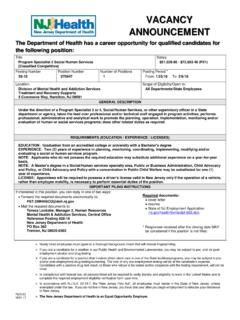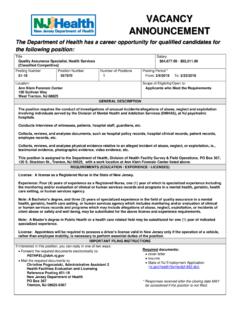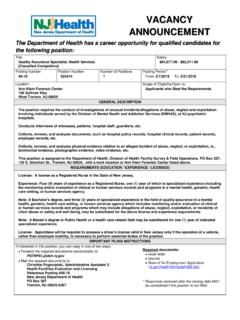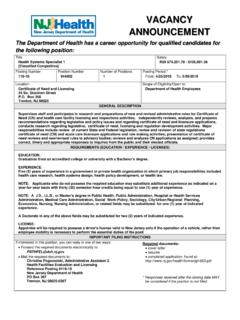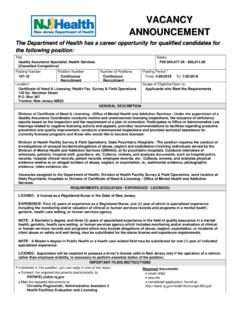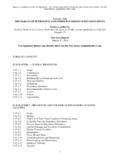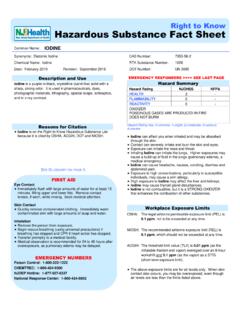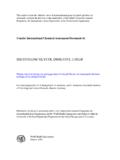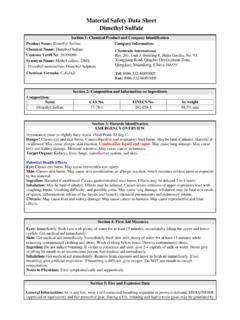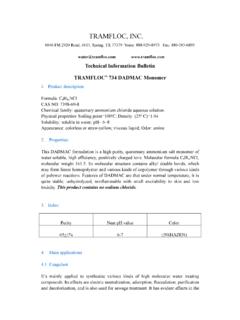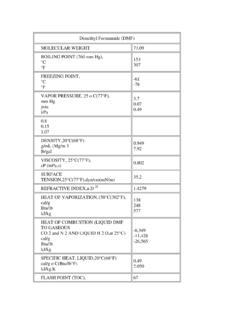Transcription of DIMETHYL ACETAMIDE HAZARD SUMMARY
1 Common Name: DIMETHYL ACETAMIDE CAS Number: 127-19-5 DOT Number: None ---------------------------------------- ------------------------------- HAZARD SUMMARY * DIMETHYL ACETAMIDE can affect you when breathed in and by passing through your skin. * Contact can cause skin and eye irritation. * Breathing DIMETHYL ACETAMIDE can irritate the nose and throat. * High or repeated exposure can cause brain effects, including depression, lethargy, hallucinations and other personality changes.
2 * DIMETHYL ACETAMIDE may damage the liver causing nausea and/or jaundice. IDENTIFICATION DIMETHYL ACETAMIDE is a colorless liquid with a faint ammonia-like odor. It is used as a solvent for plastics, resins and gums. REASON FOR CITATION * DIMETHYL ACETAMIDE is on the Hazardous Substance List because it is regulated by OSHA and cited by ACGIH, NIOSH and NFPA. * Definitions are provided on page 5. HOW TO DETERMINE IF YOU ARE BEING EXPOSED The New Jersey Right to Know Act requires most employers to label chemicals in the workplace and requires public employers to provide their employees with information and training concerning chemical hazards and controls.
3 The federal OSHA HAZARD Communication Standard, , requires private employers to provide similar training and information to their employees. * Exposure to hazardous substances should be routinely evaluated. This may include collecting personal and area air samples. You can obtain copies of sampling results from your employer. You have a legal right to this information under OSHA * If you think you are experiencing any work-related health problems, see a doctor trained to recognize occupational diseases.
4 Take this Fact Sheet with you. RTK Substance number: 0736 Date: January 1988 Revision: December 1998 ---------------------------------------- --------------------------------- * ODOR THRESHOLD = 47 ppm. * The range of accepted odor threshold values is quite broad. Caution should be used in relying on odor alone as a warning of potentially hazardous exposures. WORKPLACE EXPOSURE LIMITS OSHA: The legal airborne permissible exposure limit (PEL) is 10 ppm averaged over an 8-hour workshift.
5 NIOSH: The recommended airborne exposure limit is 10 ppm averaged over a 10-hour workshift. ACGIH: The recommended airborne exposure limit is 10 ppm averaged over an 8-hour workshift. * The above exposure limits are for air levels only. When skin contact also occurs, you may be overexposed, even though air levels are less than the limits listed above. WAYS OF REDUCING EXPOSURE * Where possible, enclose operations and use local exhaust ventilation at the site of chemical release.
6 If local exhaust ventilation or enclosure is not used, respirators should be worn. * Wear protective work clothing. * Wash thoroughly immediately after exposure to DIMETHYL ACETAMIDE and at the end of the workshift. * Post HAZARD and warning information in the work area. In addition, as part of an ongoing education and training effort, communicate all information on the health and safety hazards of DIMETHYL ACETAMIDE to potentially exposed workers. DIMETHYL ACETAMIDE page 2 of 6 This Fact Sheet is a SUMMARY source of information of all potential and most severe health hazards that may result from exposure.
7 Duration of exposure, concentration of the substance and other factors will affect your susceptibility to any of the potential effects described below. ---------------------------------------- --------------------------------- HEALTH HAZARD INFORMATION Acute Health Effects The following acute (short-term) health effects may occur immediately or shortly after exposure to DIMETHYL ACETAMIDE : * Contact can cause skin and eye irritation. * Breathing DIMETHYL ACETAMIDE can irritate the nose and throat.
8 Chronic Health Effects The following chronic (long-term) health effects can occur at some time after exposure to DIMETHYL ACETAMIDE and can last for months or years: Cancer HAZARD * According to the information presently available to the New Jersey Department of Health and Senior Services, DIMETHYL ACETAMIDE has not been tested for its ability to cause cancer in animals. Reproductive HAZARD * There is limited evidence that DIMETHYL ACETAMIDE may damage the developing fetus. Other Long-Term Effects * High or repeated exposure can cause brain effects, including depression, lethargy, hallucinations and other personality changes.
9 * DIMETHYL ACETAMIDE may damage the liver causing nausea and/or jaundice. MEDICAL Medical Testing If symptoms develop or overexposure is suspected, the following is recommended: * Liver function tests. * An exam of the nervous system emphasizing personality changes. Any evaluation should include a careful history of past and present symptoms with an exam. Medical tests that look for damage already done are not a substitute for controlling exposure.
10 Request copies of your medical testing. You have a legal right to this information under OSHA Mixed Exposures * Because more than light alcohol consumption can cause liver damage, drinking alcohol can increase the liver damage caused by DIMETHYL ACETAMIDE . WORKPLACE CONTROLS AND PRACTICES Unless a less toxic chemical can be substituted for a hazardous substance, ENGINEERING CONTROLS are the most effective way of reducing exposure. The best protection is to enclose operations and/or provide local exhaust ventilation at the site of chemical release.
